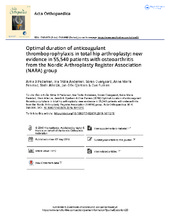| dc.contributor.author | Pedersen, Alma B. | en_US |
| dc.contributor.author | Andersen, Ina Trolle | en_US |
| dc.contributor.author | Overgaard, Søren | en_US |
| dc.contributor.author | Fenstad, Anne Marie | en_US |
| dc.contributor.author | Lie, Stein Atle | en_US |
| dc.contributor.author | Gjertsen, Jan-Erik | en_US |
| dc.contributor.author | Furnes, Ove | en_US |
| dc.date.accessioned | 2020-08-10T07:45:55Z | |
| dc.date.available | 2020-08-10T07:45:55Z | |
| dc.date.issued | 2019 | |
| dc.Published | Pedersen AB, Andersen IT, Overgaard S, Fenstad F, Lie SA, Gjertsen JE, Furnes O. Optimal duration of anticoagulant thromboprophylaxis in total hip arthroplasty: new evidence in 55,540 patients with osteoarthritis from the Nordic Arthroplasty Register Association (NARA) group. Acta Orthopaedica. 2019;90(4):298-305 | eng |
| dc.identifier.issn | 1745-3674 | |
| dc.identifier.issn | 1745-3682 | |
| dc.identifier.uri | https://hdl.handle.net/1956/23591 | |
| dc.description.abstract | Background and purpose — The recommended optimal duration of the thromboprophylaxis treatment in total hip arthroplasty (THA) patients has been a matter of debate for years. We examined the association between short (1–5 days), standard (6–14 days), and extended (≥ 15 days) duration of thromboprophylaxis, with regards to the risk of venous thromboembolism (VTE), major bleeding, and death in unselected THA patients. Patients and methods — We performed a cohort study using prospectively collected data from the population-based hip arthroplasty registries, prescription databases, and patient administrative registries in Denmark and Norway. We included 55,540 primary THA patients with osteoarthritis Results — The 90-day cumulative incidence of VTE was 1.0% for patients with standard treatment (reference), 1.1% for those with short-term treatment (adjusted hazard ratio [aHR] of 1.1, 95% confidence interval (CI) 0.8–1.5) and 1.0% for those with extended treatment (aHR of 0.9, CI 0.8–1.2). The aHRs for major bleeding were 1.1 (CI 0.8–1.6) for short and 0.8 (CI 0.6–1.1) for extended vs. standard treatment. In addition, patients with short and extended treatment had aHRs for death of 1.2 (CI 0.8–1.8) and 0.8 (CI 0.5–1.1) vs. standard treatment, respectively. Patients who started short treatment postoperatively had an aHR for death of 1.8 (CI 1.1–3.1) and absolute risk difference of 0.2%, whereas patients who started short treatment preoperatively had an aHR for death of 0.5 (CI 0.2–1.2) and absolute risk difference of 0.3% compared with patients who had standard treatment with post- and preoperative start, respectively. Interpretation — In routine clinical practice, we observed no overall clinically relevant difference in the risks of VTE and major bleeding within 90 days of THA with respect to thromboprophylaxis duration. However, our data indicate that short-term thromboprophylaxis started postoperatively is associated with increased 90-day mortality. The significance of these data should be explored further. | en_US |
| dc.language.iso | eng | eng |
| dc.publisher | Taylor & Francis | eng |
| dc.rights | Attribution CC BY | eng |
| dc.rights.uri | http://creativecommons.org/licenses/by/4.0 | eng |
| dc.title | Optimal duration of anticoagulant thromboprophylaxis in total hip arthroplasty: new evidence in 55,540 patients with osteoarthritis from the Nordic Arthroplasty Register Association (NARA) group | en_US |
| dc.type | Peer reviewed | |
| dc.type | Journal article | |
| dc.date.updated | 2019-12-10T19:02:41Z | |
| dc.description.version | publishedVersion | en_US |
| dc.rights.holder | Copyright 2019 The Author(s) | |
| dc.identifier.doi | https://doi.org/10.1080/17453674.2019.1611215 | |
| dc.identifier.cristin | 1710071 | |
| dc.source.journal | Acta Orthopaedica | |

